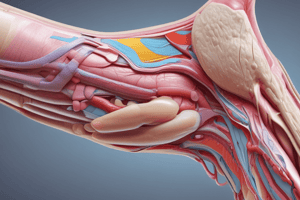Podcast
Questions and Answers
What is the primary function of tendons?
What is the primary function of tendons?
- To store energy for muscle movement
- To absorb impact during physical activity
- To enhance muscle size and strength
- To attach muscles to bones and facilitate movement (correct)
What are the potential consequences of inadequate tendon training?
What are the potential consequences of inadequate tendon training?
- Improved muscle flexibility
- Increased risk of tendon injuries like tendinitis (correct)
- Reduced risk of muscle cramps
- Enhanced cardiovascular endurance
Which of the following is an example of an isometric movement?
Which of the following is an example of an isometric movement?
- Performing bicep curls with weights
- Holding a squat position against a wall (correct)
- Jumping repeatedly
- Running at a steady pace
What type of training primarily involves quick, fast contractions aimed at tendon strength?
What type of training primarily involves quick, fast contractions aimed at tendon strength?
Which of the following statements about isometric exercises is false?
Which of the following statements about isometric exercises is false?
What is one of the benefits of controlled muscle lengthening (eccentric movements) in tendon training?
What is one of the benefits of controlled muscle lengthening (eccentric movements) in tendon training?
What should be included in a well-rounded tendon training program?
What should be included in a well-rounded tendon training program?
How do prolonged weight holds specifically benefit tendon health?
How do prolonged weight holds specifically benefit tendon health?
What is the primary benefit of incorporating eccentric exercises in a training routine?
What is the primary benefit of incorporating eccentric exercises in a training routine?
Which of the following exercises is an example of a concentric movement?
Which of the following exercises is an example of a concentric movement?
What is a drawback of strictly performing concentric movements?
What is a drawback of strictly performing concentric movements?
Which movement type should be performed first to optimize tendon strengthening?
Which movement type should be performed first to optimize tendon strengthening?
What role do concentric movements play in muscle training?
What role do concentric movements play in muscle training?
Which two types of exercises should be incorporated after isometric movements in a training routine?
Which two types of exercises should be incorporated after isometric movements in a training routine?
During which phase of a movement do concentric contractions occur?
During which phase of a movement do concentric contractions occur?
Which of the following best describes the focus of plyometric training in relation to tendons?
Which of the following best describes the focus of plyometric training in relation to tendons?
What type of exercise is emphasized by plyometric movements?
What type of exercise is emphasized by plyometric movements?
Which of the following best describes the goal of isometric movements?
Which of the following best describes the goal of isometric movements?
What is a key benefit of eccentric movements?
What is a key benefit of eccentric movements?
When should plyometric movements be incorporated into a training program?
When should plyometric movements be incorporated into a training program?
Which of the following is NOT an example of a plyometric movement?
Which of the following is NOT an example of a plyometric movement?
What is the effect of plyometric training on tendons?
What is the effect of plyometric training on tendons?
Which of the following movements emphasizes controlled muscle lengthening?
Which of the following movements emphasizes controlled muscle lengthening?
What is a primary purpose of performing slow squats?
What is a primary purpose of performing slow squats?
Flashcards are hidden until you start studying
Study Notes
Understanding Tendons
- Tendons are strong connective tissues connecting muscles to bones, enabling force transfer and skeletal movement control.
- Tendons are susceptible to injuries due to overuse, repetitive strain, and aging.
Why Train Tendons?
- Tendon-specific training improves joint health, reduces pain and stiffness, and promotes speed and agility.
- Without proper conditioning, tendons can become a weak link, making you more prone to tendinitis or tendon ruptures.
Types of Tendon Training Exercises
- Isometric Movements (Prolonged Weight Holds): Hold a position under tension without changing muscle length or joint angle.
- Benefits: Increased tendon stiffness, improved neuromuscular control, reduces tendon pain.
- Examples: Wall sits, static holds, plank holds.
- When to use: Start with isometric movements to build a foundation of stiffness and strength.
- Plyometric Movements (Quick, Fast Contractions): Emphasize explosive power and rapid movements.
- Benefits: Increased power and elasticity, enhanced explosiveness.
- Examples: Jump squats, box jumps, clap push-ups, bounding drills.
- When to use: Incorporate after establishing baseline strength and stiffness through isometrics and eccentrics.
- Eccentric Movements (Controlled Muscle Lengthening): Involve muscle lengthening while under tension, placing high stress on tendons.
- Benefits: Increased tendon strength and hypertrophy, improved muscle-tendon coordination, reduced injury risk.
- Examples: Slow squats, eccentric bicep curls, negative pull-ups.
- When to use: Incorporate early on after isometric movements.
- Concentric Movements (Pure Muscle Shortening): Muscle shortens as it contracts, generating force to overcome resistance.
- Benefits: Improved muscle strength and mass, enhanced blood flow.
- Drawbacks: Limited direct impact on tendons, less tendon stiffness adaptation.
- Examples: Bicep curls (lifting phase), push-up (pushing up phase), leg extension.
- When to use: Use to build overall muscle strength and power, which indirectly supports tendon health.
Combining Movements for Optimal Tendon Health
- Start with isometric movements for a foundation.
- Add eccentric exercises to strengthen tendons through their full range of motion.
- Incorporate plyometric training to improve handling of quick, high-intensity loads.
- Use concentric movements for a solid muscle foundation.
Sample Workout Plan
- Isometric Holds (3 sets): Wall sits, or static calf raises for 30-45 seconds.
- Eccentric Lowering (3 sets of 8-10 reps): Slow squats (3-5 seconds lowering) or eccentric bicep curls.
- Plyometric Movements (3 sets): Jump squats or box jumps with quick, explosive movements.
Studying That Suits You
Use AI to generate personalized quizzes and flashcards to suit your learning preferences.




